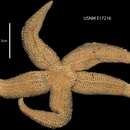fr
noms dans le fil d’Ariane


“Asterias (Smilasterias) scalprifera, n. sp. (Pl. C. figs. 4-6; Pl. CIII. figs. 1 and 2).
Rays five. R = 58 mm.; r = 8 mm. R > 7r. Breadth of a ray a little beyond the base, 11.5 mm.
Rays elongate, subcylindrical, rather swollen near the base, but not abruptly, thence tapering gradually to the extremity. Disk small, convex and high. Interbrachial arcs acutely angular, the rays appearing to be crushed together at the base.
The abactinal area is beset with small plates, the majority of which are nearly as long as broad. A median radial series of plates rather larger than the others proceeds regularly and uninterruptedly from the disk to the extremity. The plates on each side of this cannot be said to form regular longitudinal lines, though a tendency towards this arrangement appears to be present; a transverse correspondence of the plates is much more distinctly traceable. The plates bear a number of small, low, round-tipped, equal. papilliform spinelets, which are widely spaced upon the plate, and amongst them are large forcipiform pedicellariae widely spaced and isolated, and nearly as large as the spinelets, from which they can only be distinguished by careful examination with a magnifying-glass. No definite order of arrangement of the spinelets and pedicellariae on the plates is to be observed, but owing to the presence of indistinct transverse wrinkles and sutures, and the transverse correspondence of plates above mentioned, a certain general transverse character is given to the disposition of the spinulation as a whole. One or two papulae are present in the interspaces between the plates.
The armature of the adambulacral plates consists of three spinelets closely placed at the base, but radiating a little apart, and forming a transverse and very slightly oblique series on each plate. The spinelets are equal in length, slightly compressed, broad, chisel-shaped, and truncate at the tip.
Immediately external to the adambulacral plates follows a series of actinal (? infero-marginal) plates, upon which are borne four spinelets, closely placed at the base, radiating slightly apart, forming a very oblique series upon the plate, the base line being at an angle of 45° to the margin of the furrow; these spinelets are equal, broad, more compressed than those on the adambulacral plates, slightly flaring, chisel-shaped, and truncate at the tip. No pedicellariae are associated either with these spinelets, or with those forming the armature of the adambulacral plates. This series of actinal (? infero-marginal) plates is separated from the next above by a narrow space in which papules are present. The succeeding series, which is perhaps the representative of a series of supero-marginal plates, forms a regular longitudinal line, and the spinulation of the plates is precisely similar to that on the abactinal plates generally, excepting that a single spinelet near the inferior edge of each plate is a trifle longer and is flattened, truncate and chisel-shaped at the tip, simulating in miniature the chisel-shaped spines on the actinal and adambulacral plates. This single spine on each plate forms a regular series along the ray, but is so small that it is scarcely noticeable without a magnifying-glass.
The madreporiform body, which is remarkably small and situated near the margin at the summit of the almost vertical interbrachial arc, is surrounded by a closely packed circlet of rounded papilliform spinelets. It is elliptical or circular in shape, and the surface, which is slightly concave, is grooved with fine radiating striations.
Colour in alcohol, greyish white, with traces of a purplish colour on the abactinal surface in the case of a large example. In a smaller specimen the purple colour is more fully preserved.
Localities.—Off Marion Island. Depth 50 fathoms.
Station 151. Off Heard Island. February 7, 1874. Lat. 52° 59' 30" S., long. 73° 33' 30" E. Depth 75 fathoms. Volcanic mud. Surface temperature 36.2° Fahr.
Remarks.—This species is distinguished by the transverse series of three flattened spinelets on the adambulacral plates, and by the presence of the remarkable obliquely placed combs of four flattened spinelets on the infero-marginal plates. The character of the abactinal plating and spinulation is also characteristic, and produces a habit distinctly different from that of any other species except Asterias (Smilatsterias) triremis.”
(Sladen, 1889: 578-179)
Smilasterias scalprifera is een zeester uit de familie Stichasteridae.
De wetenschappelijke naam van de soort werd in 1889 gepubliceerd door Percy Sladen.
Bronnen, noten en/of referenties